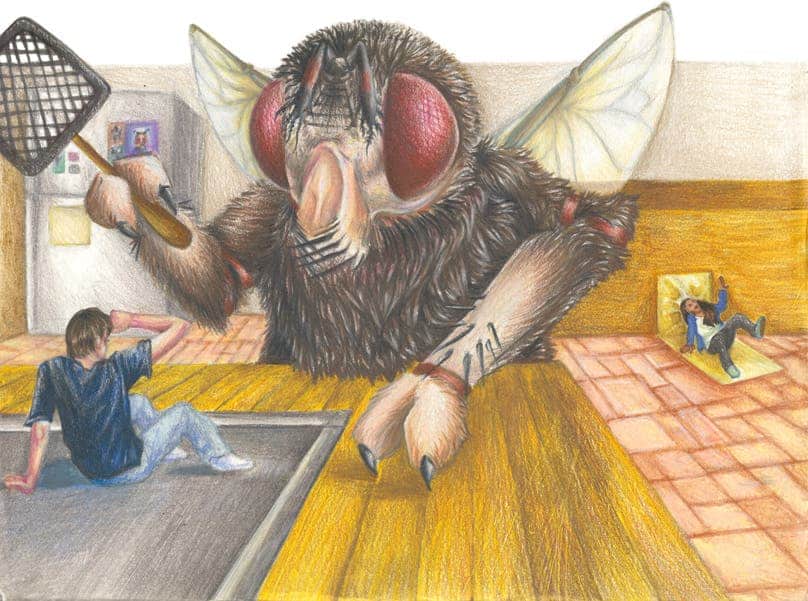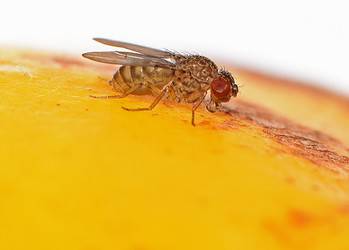Fruit flies experience fear, one of the primary emotions, according to a new research that suggests there’s much more to flies scattering about in the face of a swatter than a mere robotic reflex. But do the flies feel other emotions too? That’s an extremely difficult question to answer, since the researchers themselves aren’t even sure what they’ve been observing is genuine fear. It does, however, bear all the characteristics of fear. The findings are important since the show that other “lesser beings” that have a primitive nervous system like other insects or spiders might also experience fear, and possibly other emotions as well like happiness or sadness. Who knows, maybe love too?

“No one will argue with you if you claim that flies have four fundamental drives just as humans do: feeding, fighting, fleeing, and mating,” lead author William Gibson said in a press release about the study published in the Journal Current Biology.
“Taking the question a step further — whether flies that flee a stimulus are actually afraid of that stimulus — is much more difficult,” added Gibson, who is a Caltech postdoctoral fellow.
Attaching electrodes to the fly’s brain is difficult and likely doesn’t work very well. So, the best method the scientists had at their disposal to gauge whether or not flies feel fear was purely observational. So, in this case, you need to know very well what are the defining characteristics of fear and how the emotion plays out to single out the behavior in the flies. Gibson argues that there are four basic tenets of fear: persistence, scalability, generalization across different contexts and trans-situational. These are called emotion primitives.
“If you’re hiking and hear a rattlesnake, your heart is going to pound and you experience fear long after the snake is gone,” said California Institute of Technology biologist and lead author David Anderson explaining persistence. Scalability refers to the amplification of the emotion. If you see a rattlesnake nest filled with four, five or even ten snakes you should feel more afraid. Generalization and trans-situational refers to responding in a similar fashion, but in different contexts and situations. If you learn to be afraid of gun shots, you might also shiver when you hear the rattle of a pan hitting the floor or a loud clap.

The researchers placed hungry flies in an arena and watched how they behaved when a shadow was overcast. When the shadow was cast over the food, the flies would repeatedly scatter away. Sometimes, the flies froze in place – a defense mechanism often observed in many animals, be them rodents or humans. It also took some time before the flies returned to the food source, despite they were starving, suggesting there’s a lasting psychological state and not a momentary escape reflex. The flies moved away each time the shadow was placed, suggesting persistence. When more than one shadow was cast over the food, most flies scattered at a higher speed, suggesting scalability.
This sort of research is important, since it provides a basic foothold for studying how basic emotions are formed, and possibly how these emotions differ across other species. For instance, Gibson and Anderson can never know for sure what’s in the mind of a fly, but by all “verbal accounts” it does seem to feel fear, at least. It’s unlikely, however, that it feels fear in the way humans do (i.e. not as complex). The findings were reported in Current Biology.
“The argument that this paper makes is that the Drosophila (a type of fly) system may be an excellent model for emotion states due to the relative simplicity of its nervous system, combined simultaneously with the behavioral complexity it exhibits,” Gibson explained.
“There are two difficulties with taking your own experiences and then saying that maybe these are happening in a fly. First, a fly’s brain is very different from yours, and second, a fly’s evolutionary history is so different from yours that even if you could prove beyond any doubt that flies have emotions, those emotions probably wouldn’t be the same ones that you have,” he says. “For these reasons, in our study, we wanted to take an objective approach.” –
In the future, the researchers say that they plan to combine the new technique with genetically based techniques and imaging of brain activity to identify the neural circuitry that underlies these defensive behaviors. The ultimate goal is to identify those neural mechanism involved in creating the emotion primitive responses.






